Have you got the horn: Besson v Yamaha
1-Aug-20054BR looks at the two leading tenor horns on the market - the Besson Sovereign and the Yamaha Maestro to see which one comes out on top.
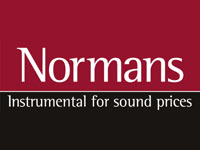 4BR looks at the two market leading tenor horns and gives them a thorough going over to see which one we think really cuts the mustard.
4BR looks at the two market leading tenor horns and gives them a thorough going over to see which one we think really cuts the mustard.
Both instruments were lent to us by Normans Musical Instruments, where both can be purchased.
Introduction:
Of all the instruments in the brass band, the tenor horn is perhaps the one that has undergone the least amount of change since it first arrived on our shores around 150 years ago.
That it became an integral part of the emerging brass band stems from the manufacture of saxhorns by the Belgian, Adolphe Sax, and his association in particular with the British instrument making Distin family, after they had met in Paris in 1844. Distin had cornered the market in Britain in those early years, and by the time the Mossley Temperance Band had won the British Open with a brand new set of saxhorns in 1853, the trend had become the norm, and the alto or tenor horn had secured its place as a peculiarly British brass band instrument.
From that time on however it has suffered in comparison to the other traditional principal instruments. Its technical development has certainly not been on a par with say the euphonium or even baritone, whilst it is only in the past twenty years or so that composers have awoken to the real potential of the instrument as a true solo voice. Prior to this, the tenor horn had been one of the ‘forgotten' instruments of the banding world – seen as a rather effeminate, lightweight voice, of use only as a ‘filler' between the shrill brilliance of the cornets and the mellow depth of the euphonium section.
Today though, manufacturers and composers have finally realised the potential of the instrument, whilst there is a whole plethora of outstanding performers who can stand with pride against the star performers on other more readily accessible solo instruments.
4BR therefore took the opportunity to have a look at the two current best selling tenor horns on the market and cast a eye over them to find out which one we felt was the best.
We have had the chance to play on the Yamaha Maestro YAH-602SUK (Silver Plate) and the Besson Sovereign BE950 – thanks to our friends at Normans Musical Instruments.
As usual the categories we look at are:
1) Build Quality/ Design
2) Intonation
3) Ease of Blowing/ Tonal quality
4) Overall performance/ Value for money
Each category can score up to a maximum of 25 points to give an overall score out of 100.
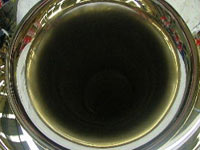 Build Quality/ Design
Build Quality/ Design
Where an instrument is built is not really an issue nowadays. Traditionalist may balk at the thought of buying something not put together by so called ‘British Craftsmen', but in all honesty, and with all the high tech machines that manufacturers have at their disposal, the ‘hand made' badge usually only refers to the person who solders the joints and polishes the silver plate.
As for design, there is a striking similarity between the two instruments in looks – although it would take a formula 1 designer to change an appearance that has remained relatively unscathed for over a century.
This what we thought though.
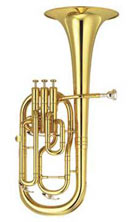 Yamaha Maestro:
Yamaha Maestro:
Yamaha have worked hard over the years to raise their standards of build quality from the early days of instruments that seemed to been have been made out of discarded bits of old motorcycles and World War Two battleships. They now produce high quality instruments throughout their entire range, and the Maestro is no exception it seems on first glance.
The instrument has a solid feel and is well balanced with a neutral balanced centre point. The bright silver plate on our instrument was well finished, although a number of the joints had a rough feel to them, as if the solder hadn't been burnished long enough.
The valves are Monel hand lapped centre sprung and are well enough put together, although they do have a somewhat flimsy look about them. Valve tops and caps fit snugly with the felts on the valve cap flush and secure. The valves though are a bit noisy and a little stiff (although this will improve through use).
The slides are a bit of a tight fit, with the main tuning slide alarmingly short, with less than 3.5cm of travel - not a good sign if you play in a sharp band. The rest are OK, whilst the three water keys are well positioned but a little cheap in feel. You wonder how long the third slide one will last.
Plenty of strengthening struts to keep the whole instrument as solid as Volvo cabriolet car, but the lyre key attachment seemed to have been made in the Japanese equivalent of ‘Poundland' – ‘Yenland' perhaps - not good.
We did like the thumb rest though – a neat idea, but we were more than a little disturbed by the leadpipe, which seems to have been bolted on. Look down the bore and you see a join seal that wouldn't be out of place on an industrial boiler and made us wonder about airflow and mouthpiece fitting.
The Yamaha is a nice looking instrument and even those with hands the size of wicket keeper gloves or as dainty as Japanese Geisha girl will be able to handle the instrument with ease.
Overall: Good, but could be better. A little more care over the small things could make this so much better: 20 points
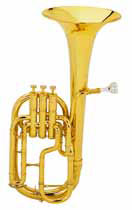 Besson Sovereign:
Besson Sovereign:
The name ‘Sovereign' has over the years been a mark that has been a sign of undoubted quality. A bit like those Morgan sportscars whose design hasn't really changed a great deal since the invention of the internal combustion engine, the 2005 version of the ‘Sovereign' is still easily identifiable as a refined incarnation of the original when horn players wore moustaches and purple nylon band uniforms were seen as ‘cutting edge'.
The latest tenor horn to proudly bear the name is still a good looking bit of kit; lean and well toned with a balanced feel in the hand. The bright silver plate was well finished with no bleeds or shadows and the joints were better finished than the Yamaha – a bit more work had gone into smoothing them out.
Although Sovereigns do come in lacquer finish, they are not the same quality as the BSP we are informed, so always opt for BSP – even the price is the same from Normans.
The valves though seem to be out of the ark. Although they were well made, top sprung stainless steel valves were the equivalent of cutting edge design technology when Isambard Kingdom Brunel was a lad. As sturdy as a shire horse, and just about as slow to start with, it is one area of this instrument that time has caught up with. Saying that though, they were silent, flush fitting and didn't let us down.
The slides were smooth but snug with the main slide having a 6.5cm travel, meaning that even the worse out of tune horn player could move it like Don Lusher to get in tune. The same goes for the rest as well, whilst the three water keys are as stiff as an English upper lip, although why the main water key is positioned in an opposite direction to the other two was a bit baffling. They will take a fair bit of spit removal though.
The rest of instrument is well put together, with plenty of struts to keep it as solid as brick outhouse, whilst the lyre attachment does just what it should do. Three cheers for that.
The leadpipe is well positioned and doesn't suffer with a poor join seal either, whilst the tried and tested design has meant that everyone with hands the size of George Foreman to Tiny Tim has been able to handle the instrument without too many problems.
Overall: As trusty as the Queen Mum's butler; old perhaps and a little creaky on the valves, but still exuding a touch of class: 21 points
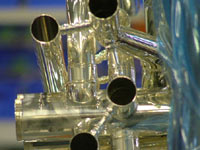 Intonation:
Intonation:
The trouble with tenor horns is that they are like flute players in an orchestra – sometimes the only way to get them in tune is to shoot one of them.
No other instrument in the brass band causes as many problems, and you can sometimes multiply that by a value of three if you have got a trio of players who have as much regard to the use of their ears as Van Gogh did.
So what about our two here? Individually they were both good, but the real test would surely be when they joined their friends in the horn section.
Yamaha Maestro:
Pretty good we must say. Given that our test driver played the instrument against a Maestro and a Sovereign in a horn section in rehearsal, the outcome wasn't anywhere as poor as we thought it would be.
The bottom end of the range seemed secure with open notes a touch sharp to start off with. That was soon rectified with a judicious tweak on the main tuning slide (although once more the lack of appreciable travel could cause problems when mutes are used) and things seemed settled.
Both first and third slide tuning was pretty good in the middle range, but things did tend to go a little sharp as we got higher. Top G seemed OK, but top A and the stratosphere did make you wince at times.
Good players should be able to lip most things in tune, but the notes above the stave tended to be a bit bright – especially when played loudly. This may be a real problem if your horn section hasn't got chops like Mick Jagger, but as the instrument is really aimed at players who should have mastered the basics, it shouldn't cause too many problems for a nervous conductor trying the opening bars of ‘Cloudcatcher Fells'. Care will have to be taken though.
Overall: On its own a fine example, but teamed up it could just niggle. That may be more to do with your players rather than the instrument, so benefit of the doubt from us: 21 points
Besson Sovereign:
Also pretty good, although it did take a bit more time for our test driver to get it spot on in mixed company.
The bottom end was secure, although there was a need to really open the throat like George Best drinking a pint of lager to keep the really low stuff from going sharp.
The middle range was fine – no need for funny fingering whilst the extra travel on the main tuning slide meant that even the worse serial tuning offender can tweak it as much as a performance of the ‘Acrobat' to get it back on track.
Both first and third slide tuning was secure as well, although just like the Maestro the upper register tended to go a touch sharp, especially when giving it a bit of welly.
The really high stuff needs a bit of care and attention to stop it going too far out, but again, a good player should be able to cope. Top A and above can make you wince though, but the opening bars of ‘Cloudcatcher' should be OK.
Overall: Another fine upstanding individual but put together with their friends in the middle of the band and a few little winces and gripes may appear. Again, that may be to do with your players rather than the kit they are playing, so another ‘not proven' verdict as they say in Scotland: 21 points
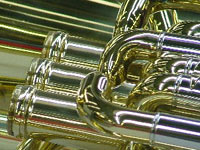 Ease of Blowing/ Tonal Quality:
Ease of Blowing/ Tonal Quality:
This is where the tenor comes into its own. Played well, it can sound like musical honey, but played badly and it can sound as disturbing as spaniel eating a hot potato. (Please don't try that at home though – but believe us)
In these modern days of bands that can blow a charging rhino off its feet from 40 yards, horn players need the capacity to honk it out like a pack of wild geese when required, but also play with a delicacy only a spinster's needlepoint can display.
There is a need therefore for the instruments to be both free blowing, yet able to maintain their tonal quality throughout the dynamic range. This is how they powered up.
Yamaha Maestro:
The Maestro has a 205mm (8 1/16th inch) bell and a bore of 11.9mm (0.469 inches), so you need the lung capacity of Lance Armstrong to fill it at times.
The good news though is that it is a very free blowing instrument. The bad news is that is can lose a great deal of tonal quality at both ends of the dynamic range.
Right through the range you can pump the air through, but it does sound a little bright and ‘tinny' in timbre when at its limits. Overblow and it can sound brash and harsh, whilst not putting enough air through when it is clenched buttocks time and the dynamic level is piano or below and it lacks some warmth.
Keep the instrument under control though and it produces a wonderful dark and rich tone which can be subtlety changed by a good player, especially if they can cut out the vibrato.
You just feel though that you have to work quite hard to make you sound like Sheona White instead of Jimmy White, and that harshness of tone isn't a welcome sound in a true brass band.
Overall: Great when kept on a tight leash, but let the dogs of war loose and the shrapnel could fly: 19 points
Besson Sovereign:
The Besson has a 203mm (8 inch) bell and a bore of 11.84mm (0.466 inches), so you don't have to quite be Lance Armstrong, but you could still need the lungs capable of blowing up a hot water bottle to fill it at times.
The good news is that it is also a free blowing instrument, whilst the bad news isn't in any way as bad as that found with the Maestro.
It can of course be blown out of shape by over enthusiastic players who really want to play the bass trombone, but its construction has the quality about it to cope with just about anything that goes through it.
At the limits it still retains a true sense of timbre – less brassy and bright than the Yamaha when the doors of hell are opened, whilst when there is a need to turn the volume really down, it can handle even the smallest amounts of airflow whilst still retaining a secure tonal quality. You still have to keep a constant flow going through the instrument – but it does reward you if you take the risk.
When played with comfort it has a plummy dark sound that can be lightened in timbre with a bit of intelligence or darkened further if your conductor wants to make you sound like Peruvian throat singers.
You don't have to work as hard with the Besson to sound like Sandy Smith rather than Harvey Smith, so the rewards are there if you use a bit of intelligence and do a bit of practice.
Overall: Fine stuff. Only those with congenital madness will try to blow it straight, but even then the Sovereign will have the last laugh: 22 points
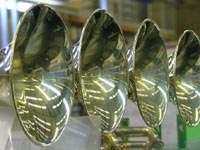 Overall Performance/ Value for Money
Overall Performance/ Value for Money
Yamaha Maestro:
Overall the Yamaha is a premium instrument aimed at the top end of the market. It just about makes it there for us, although it still has a few rough edges to it that could be ironed out with some care and attention.
The build quality needs tightening up for us, whilst the intonation could needle if care isn't taken. The major flaw for us though is the timbre, which can sound a little cheap and nasty at both ends of the dynamic range.
It comes in a sturdy black case that looks as if a bloke who last helped make a hammer drill toolbox has designed it, but it does its job well enough. The catches and locks are pretty good, but inside the case has little or no space for those extras such as music or mutes. There is no lyre either.
The instrument does come with a pretty awful Yamaha mouthpiece, (although thankfully the makers have made space for a second mouthpiece in the case) a polishing cloth, valve oil, some valve grease and a ower's manual in five different languages, so you can brush up on your Japanese, Spanish, German and French when you have a few bars rest.
The Yamaha is retailed at £2109.00, but you can pick up some pretty good deals if you shop around.
Normans for instance are selling them at £1,279.85 including VAT (or £1,089.23 without) for the lacquered version, with the bright silver plate going for £1,370.85 including VAT (£1,166.68 without).
That's good value, but you really have to ask if it is all worth it, seeing that you are looking at an instrument that is top of its range.
Overall: Not quite as good as it could be for us: 20 points
Besson Sovereign:
It has stayed the course and it has been purchased in its thousands over the years, so could so many players have been wrong in choosing the Sovereign?
No. It may have a few flaws that have come with age (the valves need an upgrade) and it could be a bit wayward intonation wise in the wrong hands, but overall it still maintains a very high level of build quality, secure ease of blowing and a wonderful timbre.
Perhaps the next generation of ‘Prestige' models may improve things even further, but for the time being, the ‘Sovereign' is still head and shoulders above its nearest rival for us. It still has that hint of class that the Yamaha lacks.
It too comes in a sturdy case (in a much more fetching dark burgundy with matching interior), and although it lacks room for music inside, it does have a neat cubbyhole for those little things that really matter and does come with a lyre! The locks and catches are well made and it has been designed by someone who actually does know what a tenor horn looks like.
There is also the added bonus of a proper Denis Wick mouthpiece, cloth, valve oil and a very nice DVD, which shows the purchaser the process by which their instrument was made, with the accompaniment of Black Dyke no less. A nice touch that, and it can also double up as a drinks coaster as well after you have finished with it.
The Besson retails at a slightly higher RRP of £2,265.00, but good deals are available.
Normans are retailing the bright silver plate version at £1,528.96 including VAT (£1,301.24 without), so just a bit more hard earned cash will have to paid out for the Sovereign instead of the Maestro.
Again, it is good value for what you get and for us that extra is well worth it for that extra bit of quality for an instrument that still leads the pack with a bit of comfort to spare.
Overall: Still the leader and still with enough class and quality to fend off its rivals with a bit to spare: 22 points
The Result:
1st: Besson Sovereign BE950 (21/21/22/22) = 86 points
2nd: Yamaha YAH – 602SUK (20/21/19/20) = 80 points
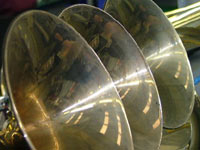 Overall Comment:
Overall Comment:
These are two very fine instruments that are the deserved market leaders.
However, the Yamaha still has a little way to catch up with the Sovereign, both in terms of build quality and tonal quality. In the end it fails to match the Sovereign because it just doesn't add up to the sum of all its parts – it has too many little rough edges to it.
The Sovereign is starting to show its age, but remains a good head and shoulders above its competitors. It set the benchmark for tenor horns some years ago and hasn't been caught yet – although like any ageing beauty, it does need a bit of nip and tuck here and there.
No doubt for us though – the Sovereign still reigns supreme – especially when you go for the BSP version.
Specifications:
Yamaha YAH – 602SUK
Bore: 11.9mm
Bell: 205mm (yellow brass)
Weight: 1.98kg approx
Finish: Lacquered or Bright Silver Plate
Mouthpiece: 38D4 (provided)
3 water keys:
Valves: top action monel hand lapped
Comes with: Cloth, valve oil, slide grease, owners manual
Price: £2109.00 RRP
Normans Musical Instruments: £1,279.85 including VAT (or £1,089.23 without) for the lacquered version, with the bright silver plate going for £1,370.85 including VAT (£1,166.68 without).
Besson Sovereign BE950
Bore: 11.84mm
Bell: 203mm (rim rolled over brass wire)
Weight 1.98kg
Finish: Lacquered or Bright Silver Plate
Mouthpiece: Denis Wick 2 (provided)
3 water keys:
Valves: top sprung stainless steel; Delrin valve guides; nickel plated
Comes with: Cloth, valve oil, DVD
Price: £2,265.00 RRP
Normans Musical Instruments: Bright Silver Plate version at £1,528.96 including VAT (£1,301.24 without). Same price for lacquered instrument.









